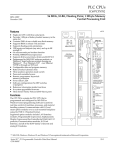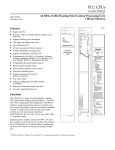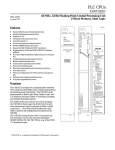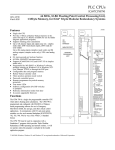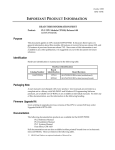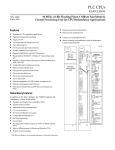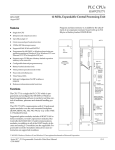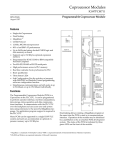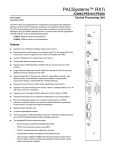Download Series 90-70 CPU, 96MHz, 32-Bit, Floating Pt, IC697CPX928, GFK
Transcript
1 PLC CPU IC697CPX928 2 GFK-1433F March 2010 2429.88/ PLC CPU 96 MHz, 32-Bit, Floating Point, 6 Mbyte (Medium) Memory Central Processing Unit 96 MHz, 32-Bit, Floating Point, 6 Mbyte (Medium) Memory Central Processing Unit (IC697CPX928 ) datasheet GFK-1433F Features D Single slot CPU with three serial ports D Provides 6 Mbytes of battery-backed memory in the same slot D Contains 256K of non-volatile user flash memory D Supports BMA in release 7.92 and later D Supports floating point calculations D 12K inputs and outputs (any mix), and up to 8K analog I/O D 0.4 microseconds per boolean function D 96 MHz, 80486DX4 microprocessor D Supports IC66 (can be IC660 or IC661) and IC697 I/O D Programmed by MS-DOSr software products, or Windowsr based software products running on Windowsr 95 or Windows NTr over Ethernet TCP/ IP or through an SNP port D Configurable data and program memory D Battery-backed calendar clock D Three position operation mode switch D Password controlled access D Remote programmer keyswitch memory protection D Seven status LEDs D Software configuration (No DIP switches or jumpers) D Reference information inside front door D In-system upgradable firmware a45724 OK P1 RUN P2 EN P3 MEM PROTECT CENTRAL PROCESSOR UNIT Functions The CPX 928 is a single slot PLC CPU that is programmed and configured by MS-DOS or Windows based programming software to perform real time control of machines, processes and material handling systems. It communicates with I/O and smart option modules over the rack-mounted backplane using the VME C.1 Standard format. Supported option modules include LAN Interface modules, Programmable Coprocessor, Alphanumeric Display Coprocessor, Bus Controller for IC660/661 I/O products, Communications modules, I/O Link Interface, and all of the IC697 family of discrete and analog I/O modules. r MS-DOS, Windows, Windows 95, and Windows NT are registered trademarks of Microsoft Corporation. CPX 928 TOP OFF B A T T E R Y ON REMOTE PROGRAMMER MEMORY PROTECT KEY POSITION FRONT OK P1 RUN P2 EN P3 MEM PROTECT ON = OK, ENABLED, PROTECTED RUN WITH OUTPUTS ENABLED RUN WITH OUTPUTS DISABLED STOP BATTERY CONNECTORS INSTALL NEW BATTERY BEFORE UNPLUGGING OLD BATTERY. USEIC697ACC701 MODULE FUNCTION 96 MHz 32 BIT CENTRAL PROCESSING UNIT SERIAL PORT 1 RS-232 SERIAL PORT 2 RS-485 COMPATIBLE FACTORY TEST SERIAL PORT 3 RS-485 COMPATIBLE USE THIS MODULE IN SLOT 1 ONLY MODULE IC697CPX928 LABEL 44A726758--153R01 PLC CPU 2 96 MHz, 32-Bit, Floating Point, 6 Mbyte (Medium) Memory Central Processing Unit GFK-1433F Firmware Storage in Flash Memory PARALLEL RACK 0 a45677A PROGRAMMER G B C or P C B S P T U M N B C FAN ONE METER FAN FAN IC66* I/O BUS -- 7500 FEET (2285 METERS) MAXIMUM RACK 1 B R M P C M IC66* I/O BLOCK RACK 6 G B C or B R M N B C ONE METER NOTE TOTAL LENGTH OF ALL INTERCONNECTING CABLES FROM BTM TO LAST BRM IS 50 FEET (15 METERS) MAXIMUM. ALL RACKS MUST BE AT SAME GROUND POTENTIAL (8 RACKS MAXIMUM). CPU BRM BTM GBC/NBC PCM PS - Operation, Protection, and Module Status Operation of this module can be controlled by the three-position RUN/STOP switch or remotely by an attached programmer and programming software. Program and configuration data can be locked through software passwords or manually by the memory protect keyswitch. When the key is in the protected position, program and configuration data can only be changed by a programmer connected parallel only (to the Bus Transmitter module). The status of a CPU is indicated by the seven green LEDs on the front of the module. IC66* I/O BUS -- 7500 FEET (2285 METERS) MAXIMUM RACK 7 P B S R M LEGEND This CPU uses flash memory for storing the operating system firmware. This allows firmware to be updated without disassembling the module or replacing EPROMs. The operating system firmware is updated by connecting a PC compatible computer to the module’s serial port and running the software included with the firmware upgrade kit. I/O TERMINATOR (LAST RACK) SELECTED CPU MODEL BUS RECEIVER MODULE, BEM711 BUS TRANSMITTER MODULE, BEM713 BUS CONTROLLER, BEM731/734 PROGRAMMABLE COPROCESSOR MODULE, PCM711 POWER SUPPLY, PWR710/711/724/748 Figure 1. PLC System Configuration Example User RAM Memory The CPX928 has a built-in memory board with 6 Mbytes of battery-backed CMOS RAM memory for user data (program, configuration, and register data) storage. User Flash Memory The CPX928 has 256K of built-in, non-volatile flash memory for user data (program, configuraton, and register data) storage. Use of this flash memory is optional. Operating Temperature This CPU’s normal operating temperature range is 0 to 50_C (32 -- 122_F). For operation between 50_C and 60_C (122 -- 140_F) , you have two choices: (1) locate a cooling fan producing 70 CFM (including filters) beneath the CPU, or (2) do not use a cooling fan, but derate the total rack power to a maximum of 70 Watts. Fan assemblies (IC697ACC721, IC697ACC724, and IC697ACC744) can be ordered for direct mounting on the IC697 rack. Refer to the IC697 Programmable Controller Installation Manual for detailed information. Installation It is the responsibility of the OEM, system integrator, or end user to properly install the PLC equipment for safe and reliable operation. Product manuals provide detailed information about installation, startup, and proper use of the PLC equipment. The installation manual, shipped with your PLC programming software, describes how to properly install the equipment. If the PLC installation must comply with supported standards, such as FCC or CE Directives, please refer to the Installation Requirements for Conformance to Standards, shipped with the PLC programming software, for additional guidelines. PLC CPU IC697CPX928 96 MHz, 32-Bit, Floating Point, 6 Mbyte (Medium) Memory Central Processing Unit GFK-1433F a45727--2 MEMORY PROTECT KEY SWITCH D Installation should not be attempted without referring to the applicable Programmable Controller Installation Manual. D Connect the battery to either of the battery connectors on the module (see Figure 2). D Put the toggle switch in the STOP position. D Put the keyswitch in the Memory Protection OFF position. D Make sure that rack power is off. D Install the CPX 928 module in slot 1 of rack 0 (see Figure 1). D Turn on power. The module should power up and the top left (OK) LED should blink. When the diagnostics have completed successfully, the top left LED stays on and the second (RUN) and third (EN) LEDs are off. The fourth (bottom left) LED (MEM PROTECT) is off if the keyswitch is in the OFF position. The CPU is now ready to be programmed (if connected parallel, the CPU can be programmed regardless of key position). After the program has been verified, the toggle switch can be moved to the appropriate operation mode position: RUN WITH OUTPUTS ENABLED, RUN WITH OUTPUTS DISABLED, or STOP. The seven LEDs indicate the position of the toggle switch, memory protection status, status of serial port activity, and the state of the program. 3 TOP HOLDING SCREW CPX 928 STATUS LEDS RUN/STOP SWITCH OPEN REPLACEMENT BATTERY CONNECTOR CURRENTLY INSTALLED BATTERY CONNECTOR SERIAL PORT 1 RS-232 TOP OFF B A T T E R Y ON REMOTE PROGRAMMER MEMORY PROTECT KEY POSITION FRONT OK P1 RUN P2 EN P3 MEM PROTECT ON = OK, ENABLED, PROTECTED RUN WITH OUTPUTS ENABLED RUN WITH OUTPUTS DISABLED STOP BATTERY CONNECTORS SERIAL PORT 2 RS-485 INSTALL NEW BATTERY BEFORE UNPLUGGING OLD BATTERY. USE IC697ACC701 MODULE FUNCTION 96 MHz 32 BIT CENTRAL PROCESSING UNIT FACTORY TEST ONLY 6 MBYTE MEMORY BOARD SERIAL PORT 1 RS-232 SERIAL PORT 2 RS-485 COMPATIBLE FACTORY TEST SERIAL PORT 3 RS-485 SERIAL PORT 3 RS-485 COMPATIBLE USE THIS MODULE IN SLOT 1 ONLY Programmer Connection, Parallel For a parallel interface (MS-DOS programmer only) the programmer is connected to the top port on the Bus Transmitter Module (IC697BEM713) as shown in Figure 1. Consult the applicable Programming Software User‘s Manual for a description of programming functions. MODULE IC697CPX928 LABEL 44A726758--153R01 BOTTOM HOLDING SCREW Figure 2. CPX 928 - Location of Major Features PLC CPU 4 96 MHz, 32-Bit, Floating Point, 6 Mbyte (Medium) Memory Central Processing Unit GFK-1433F Programmer Connection, Serial Ports SERIAL a45301 RACK 0 P S C P U G B C B T M FAN PROGRAMMER H Port 1, the top port, is RS-232 compatible. It has a 6-pin, female, RJ-11 connector, which is similar in appearance (although larger) to modular jacks commonly used for telephones and modems. Table 1. Port 1 RS-232 Signals Pin Number or N B C FAN FAN 1* 2 3 4 5 6 ** IC66* BUS (7500 FEET MAXIMUM) ONE METER RACK 1 B R M NOTES B R M TOTAL LENGTH OF ALL INTERCONNECTING CABLES FROM BTM TO LAST BRM IS 50 FEET MAXIMUM. ALL RACKS MUST BE AT SAME GROUND POTENTIAL (8 RACKS MAXIMUM). ** FORCED AIR COOLING MAY BE REQUIRED FOR PROPER OPERATION. RACK FAN ASSEMBLIES ARE AVAILABLE FOR DIRECT RACK MOUNTING. REFER TO TEXT. TERMINATOR PLUG (IC697ACC702) Figure 3. System Configuration, Serial Connection to Programmer The CPX928 has three independent, on-board serial ports. These ports, accessed by connectors on the front of the module, are used for serial interface to a programming computer or other serial devices. Starting with Firmware Release 8.00, the following two features were added to serial Ports 1 and 2: (1) support for program Load/Store operations and Datagrams, and (2) Break-Free SNP became the default protocol. For details, see the Important Product Information sheet that ships with this module. Protocols Supported Protocol CTS TXD 0V 0V RXD RTS Description Clear To Send Transmit Data Signal Ground Signal Ground Receive Data Request to Send * Pin 1 is at the top of the connector as viewed from the front of the module. IC66* BLOCK RACK 7 Signal Name Port 1 Port 2 Port 3 SNP (Slave) Yes Yes Yes Break-Free SNP (Slave) Yes Yes No SNPX No No No RTU No No No H Port 2, the center port, is RS-485 compatible and is optocoupler isolated. Port 2 has a 15-pin, female D-connector. Table 2. Port 2 RS-485 Signals Pin Number Signal Name 1* 2 3 4 5 6 7 8 9 10 11 12 13 14 15 Shield NC NC NC +5VDC RTS(A) SG CTS(B’) RT RD(A’) RD(B’) SD(A) SD(B) RTS(B) CTS(A’) Description Cable Shield No Connection No Connection No Connection Logic Power ** Differential Request to Send Signal Ground Differential Clear To Send Resistor Termination Differential Receive Data Differential Receive Data Differential Send Data Differential Send Data Differential Request To Send Differential Clear To Send *Pin 1 is at the bottom right of the connector as viewed from the front of the module. ** Note that Pin 5 provides Isolated +5 VDC power (100 mA maximum) for powering external options. D Port 3, the bottom port, is also RS-485 compatible, but is not isolated. Port 3 has a 15-pin, female D-connector. Pin-out information can be found in the IC697 PLC Installation Manual. PLC CPU IC697CPX928 96 MHz, 32-Bit, Floating Point, 6 Mbyte (Medium) Memory Central Processing Unit Three of the LED indicators on the front of the CPX928 provide serial port status. The LEDs are labeled P1, P2, and P3 to correspond to Port 1, Port 2 and Port 3, respectively. These LEDs flash when data is being transferred through their corresponding port. CPU Port 1 supports the RS232 standard. Connection from CPU Port 1 to the serial port on a programming computer or other serial device can be made with the IC693CBL316 serial cable. This cable has a 6--pin, male RJ--11 connector on the CPU Port 1 end, and a 9--pin, female D--shell connector on the other end. CPU Ports 2 and 3 support the RS422/RS485 standard, so a converter is required if connecting to an RS--232 device. This requirement can be satisfied with the IC690ACC901 miniconverter and cable kit. Or, you may build your own cables to fit the needs of your particular application. See the IC697 PLC Installation Manual for more information on serial communications, cables, and converters. Programmer Connection, Ethernet TCP/IP Connecting your programmer via an Ethernet TCP/IP network requires installation of an Ethernet Interface module in the PLC. This can be either the Ethernet Controller, IC697CMM741, or Ethernet 5 GFK-1433F Interface (Type 2), IC697CMM742. Before connecting your programmer and PLC to the Ethernet TCP/IP network you must set the IP address in the Ethernet Interface. After setting the IP address, connect the PLC and the programmer running Windows software to the Ethernet Interface. For more detailed information on the programmer connection via Ethernet TCP/IP, refer to the TCP/IP Ethernet Communications (Type 2) User’s Manual, and the Windows programming manual, GFK-1295. Configuration The IC697 CPU and I/O system is configured with MSDOS or Windows based programming software, although the MS-DOS software does not support all features, such as Bulk Memory Area (BMA), which requires the Windows software version 2.2 or later. See the IPI shipped with this module for programming software feature support details. There are no DIP switches or jumpers used to configure the system. The CPU verifies the actual module and rack configuration at power-up and periodically during operation. The actual configuration must be the same as the programmed configuration. Deviations are reported to the CPU alarm processor function for configured fault response. Refer to the applicable Programming Software User‘s Manual for a description of configuration functions. PLC CPU 6 96 MHz, 32-Bit, Floating Point, 6 Mbyte (Medium) Memory Central Processing Unit GFK-1433F Battery A lithium battery (IC697ACC701) is installed as shown in Figure 2. This battery maintains program and data memory when power is removed and operates the calendar clock. Be sure to install the new battery before removing the old battery. Specific indication of a low battery state is detailed in the applicable Programmable Controller Reference Manual. Removing a Module The instructions listed below should be followed when removing a module from its slot in a rack. D First, make sure rack power is turned off. Then, use a medium--blade, slotted screwdriver to loosen the top and bottom holding screws just enough to free the module from the rack. Note: Screws are held captive in the module, so they do not have to be removed from the module. D Grasp the board firmly at the top and bottom of the board cover with your thumbs on the front of the cover and your fingers on the plastic rack clips on the back of the cover. D Squeeze the rack clips on the back of the cover with your fingers to disengage the clips from the rack rail, then pull the board firmly toward you until it clears the rack. Table 3. Specifications for IC697CPX928 [ Battery: Shelf life Battery: Memory retention 5 years at 20_ C (68_ F) 6 months nominal without applied power. Current required from 5V bus 3.1 Amps nominal Operating Temperature 0 to 50_C (32_F to 122_F); Full rack power rating without forced air 50_C to 60_C (122_F to 140_F); 70 CFM forced air required for full rack power rating 50_C to 60_C (122_F to 140_F); Without forced air, rack power derated to a total of 70 Watts maximum Time of Day Clock accuracy 3.5 seconds per day maximum Elapsed Time Clock (internal timing) accuracy .01% maximum Serial Ports Port 1: RS-232 compatible Port 2: RS-485 compatible (optocoupler isolated) Port 3: RS-485 compatible (not isolated) VME Compatibility Programmer Serial Attachment, or other serial devices Protocols supported: SNP Slave only System designed to support the VME standard C.1 [ Refer to the latest version of data sheet GFK-0867 for product standards and general specifications. For installations requiring compliance to more stringent requirements (for example, FCC or European Union Directives), refer to Installation Requirements for Conformance to Standards. Table 4. Ordering Information Description Catalog Number Central Processing Unit 96 MHz, 32-Bit, Floating Point, 6 Mbyte Memory IC697CPX928 Lithium Battery IC697ACC701 Rack Fan Assembly, 120 VAC Rack Fan Assembly, 240 VAC Rack Fan Assembly, 24 VDC IC697ACC721 IC697ACC724 IC697ACC744 Note: For Conformal Coat option, please consult the factory for price and availability.








